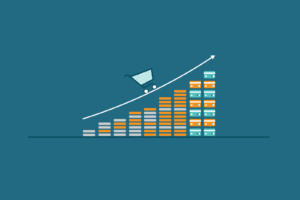
Ecommerce is simply buying and selling online. It refers to commercial transactions - the exchange of money for goods or services - using the internet.
OK, are we done? Whoa there! Sure, that is the crux of it, but there’s plenty more to learn. Let’s run through the main things you need to know about ecommerce.
Ecommerce - what’s in a name?
If you want to know the etymology of the word ‘ecommerce’, also sometimes written ‘e-commerce’ that’s easy: electronic commerce.
The term used to be used for any transactions conducted using electronic appliances, such as barcode readers, telephones and fax machines, but (for good reason - fax machines?!) all modern ecommerce definitions relate to commercial transactions on the internet.
Where does ecommerce take place?
So where do these transactions take place? Yes, obviously on the internet - but what kind of online environments are home to ecommerce?
Online storefronts
An online (or electronic) storefront is where a merchant builds a website in order to sell their products or services. Customers buy through shopping carts and ecommerce platforms such as Magento, Demandware and Shopify.
Online marketplaces
Of course huge numbers of ecommerce transactions also occur on online marketplaces. You can now buy pretty much anything you want - from groceries and electronics to software and freelance services - on marketplaces such as Amazon, eBay, Etsy and Upwork.
Social media
Social media also plays a big part in ecommerce these days, with platforms like Facebook, Pinterest and Instagram hosting adverts and directing shoppers to a merchants’ websites.
Ecommerce models
There are a few types of ecommerce model operating out there. Let’s take a look and quickly define them:
B2C (Business to Consumer)
A business sells products or services to individual consumers. For example, you buy a hat from an online retailer.
B2B (Business to Business)
A business sells goods or services to another business. For example, a marketing agency sells their services to a company needing marketing assistance.
C2C (Consumer to Consumer)
An individual sells a product or service to another individual. This is often done on online marketplaces like eBay.
C2B (Consumer to Business)
Individuals offer products or services for sale to businesses. For example, you sell a photograph you have taken to a stock photo business.
B2G (Business to Government)
A government purchases goods or services from a business online. For example, a city hires a town planner for a congestion-easing scheme.
G2B (Government to Business)
A business pays the government for goods or services, or fees online. For example, a company pays its taxes on an online government portal.
G2C (Government to Consumer)
An individual pays the government for any of the above. For example, you pay for a parking ticket online.
Forms of ecommerce
Now we’ve looked at the different models, let’s finish off with a look at the main forms of ecommerce and how different transactions can occur:
Retail
Goods are sold to the public in relatively small quantities, without any intermediary
Wholesale
The sale of products in bulk, usually to a retailer who sells them on for a profit.
Subscription
A regular, automatic purchase of goods or services that recurs until the customer decides to cancel.
Dropshipping
A company sells a product that is manufactured and shipped by a separate, 3rd-party business.
Crowdfunding
A group of consumers contribute a sum of money that is needed in order to make a product available on the market.



